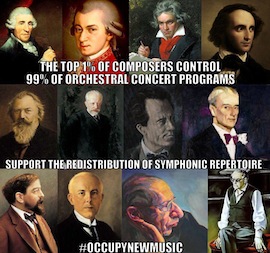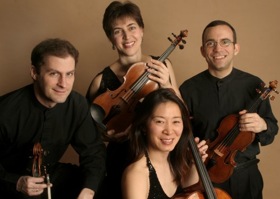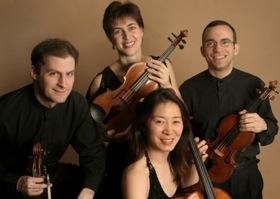
There is a graphic going viral on Facebook among classical music lovers. It states that the top 1 percent of classical composers (Bach, Mozart, Beethoven, Brahms, and cohorts) are performed on 99 percent of concert programs. It urges composers to “#occupy new music.”
In a break from the “same-ol,” the Brentano Quartet is celebrating its 20th anniversary with a fascinating project, which San Francisco Performances presented on Sunday at Herbst Theatre. Contemporary composers were tasked with completing unfinished works by the top 1 percent dead composers (the Cypress Quartet’s ongoing “Call and Response” project is similar). None of the new composers featured had dared to literally imitate their assigned companion, but rather stuck with their own personal styles. The new pieces all had great things about them but connections were usually subtle — perhaps meaningful to the composer after an explanation but often difficult to discern on first hearing.

Photo by Peter Schaaf
Charles Wuorinen’s Marian Tropes (2010) was the best example of a piece that has a clearly audible connection to the past yet still maintains an innovative edge. He wove into his own music a stream of quotations from Josquin des Prez (c. 1450–1521) and Guillaume Dufay (1397–1474). The unmistakable signature of Renaissance music, with its syncopated cadences and modal tonality, was peppered throughout the mix, blending with modern idioms of dissonance and texture. The piece had what so much new music lacks nowadays: graceful lilt, and cheerful character.
Franz Schubert’s Quartetsatz and its unfinished slow second movement was met with Bruce Adolphe’s Fra(nz)g-mentation. Adolphe took one snippet from the end of the slow movement, quickly broke it, and threw it into a rhythmic structure that had absolutely nothing to do with Schubert. After taking the bite of Schubert, he never looked back; bits of lyricism were lost in a swirl of activity that recalled the edgy section from the Quartetsatz.
Back to Bach
It wasn’t like Bach to leave a work unfinished. Toward the end of his life, the famously hard-working composer wrote The Art of Fugue: 18 fugues on the same subject. He could have gone on for even more, but the 18th fugue, the grandest of them all, ends in midsentence — a testament to the man’s mortality. It ends as if chopped off by a cleaver. With that ending, the Baroque era comes to a halt. The Brentano Quartet played Bach with an open, translucent sound, not quite “Baroque-y” but definitely with a lighter approach that let the dense counterpoint speak clearly.
[Charles Wuorinen’s] piece had what so much new music lacks nowadays: graceful lilt, and cheerful character.
Sofia Gubaidulina’s Reflections on the Theme B-A-C-H (2002) is in a completely different style from Bach’s, yet her approach resonates with him: patient and insistent. The subject (Bach’s musical signature inverted) has a clear profile and can easily be perceived every time it’s presented. Gubaidulina used extended techniques that Bach never used — glissandos (slides up and down the string as opposed to fixed pitches), ponticello (playing with the bow on the bridge to achieve a raspy sound) — but she achieves the same probing process that keeps yielding surprising new possibilities. The exploration isn’t merely technical, for the effects are laden with transcendent emotion.
Of all the new pieces on the program, John Harbison’s Finale: Presto was the most conscious effort in coming toward the paired composer’s style. Not that it could ever be mistaken for Haydn, but its aesthetic was in line with his fast finale movements: a neoclassical approach. Harbison kept Haydn’s symmetric squareness, his peasantlike regularity, his sense of brilliance and wit.
Shostakovich’s Quartet movement, written in the 1960s, was given to Stephen Hartke, who responded with From the Fifth Book (2011). Both pieces achieved a similar bleak character. The connection here seemed to come more naturally, given the relatively short time span between the two indirectly communicating composers.
The classical music world is fixated on the past, and those who try to break the mold often pay dearly at the box office.
Brentano’s performance of Mozart’s Quartet fragment in E minor, K. 417d, was one of the more interesting parts of the evening because it revealed how he composed. It starts off as Mozart normally does, but suddenly naked runs rise in the first violin part — the accompaniment disappears from underneath, comes back, disappears again. Vijay Iyer appended his response, Mozart Effects, directly onto the incomplete Mozart fragment. Mozart’s last line is repeated. And repeated again. After the third time, we realize that it’s no longer Mozart. Ha! Like Adolphe, Iyer uses the unfinished piece as a runway to take off in his own style, hardly looking back. Just when I started wondering what’s the connection? he brought back a brilliant coda that shifted into triadic harmony in fast arpeggiation by all instruments. Again, it didn’t try to be Mozart, but at least it made a nod to his musical language — a token bit of bridging back to the original composer.
The overall flow of the program was more halting than the usual chamber music concert that would feature three or four big pieces. Last year, the Brentano tried something along the same lines, patching together a mix of Haydn, Dvořák, Gershwin, arrangements of modern show tunes, and original compositions to create an array of different styles carefully curated together: a postmodern musical collage. The classical music world is fixated on the past, and those who try to break the mold often pay dearly at the box office (Herbst Theatre was barely half-full for this concert). The Brentano Quartet is to be commended for working with our well-justified obsession with the top 1 percent of past masters, while finding new ways to look at it and also bringing in new material, mining inspiration from history.

